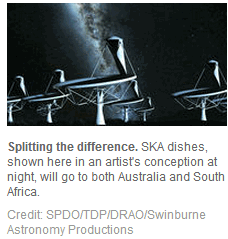|
News & Views item - May 2012 |
![]() Science and Nature Report on the SKA Solomonic Compromise.
(May 26, 2012)
Science and Nature Report on the SKA Solomonic Compromise.
(May 26, 2012)
Below is a summary of the assessments by Nature (Geoff Brumfiel) and Science (Daniel Clery) of the decision to split the construction of the radio telescope dubbed the Square Kilometre Array between South Africa and Australia (the total area of the antennae is to be approximately one-square kilometre).
Nature's Geoff Brumfiel reports:
The split will look different over the two phases of the project. In the first phase, South Africa will see 190 dishes added to its existing MeerKAT array, according to Diamond [Philip Diamond, head of astronomy and space science at CSIRO]. Australia will have 60 dishes added to its Australian SKA Pathfinder and a large number of omni-directional dipole antennas. This will give the Australian site a wide-field survey capability, whereas South Africa will be able to look deeply into a narrow part of the sky.
In phase two, the rest of the dishes will be assembled in South Africa, along with mid-frequency aperture arrays. The full complement of dipole antennas will go to Australia.
Splitting the site is politically expedient, but it will not necessarily be cheap, nor easy. Each of SKA's thousands of elements will transmit many gigabytes of data per second... As a result, both of the remote sites will require high-speed networking and powerful supercomputers, along with roads and buildings. The redundancy could significantly raise the costs of the project.
Costs for the second phase of the project seem less certain. "Because we don't have a detailed design yet for phase two it was next to impossible to estimate the costs," says Diamond. Still, he remains optimistic that additional costs can be kept low because computing and networking resources are comparatively cheap. "We've really got to get down into the detail of what we're going to build," he says.
Construction is expected to begin as soon as 2016 and first observations could be made by the end of the decade.
According to Science's Daniel Clery:
The Australia/New Zealand array, with its focus in Murchison, Western Australia, will concentrate on low frequencies, below 500 megahertz (MHz). The South African array, centered in the Karoo desert in the Northern Cape, will observe in the middle and high frequencies above 500 MHz.
"The members [of the consortium ] agreed this was the best way forward," says Michiel van Haarlem, interim director general of the SKA Organization. "It's a scheme we've only really developed over the last month or so. It will build on developments already ongoing in South Africa and Australia."
The two-site plan will modestly increase the cost of the €1.5 billion project, [Albert Zijlstra, director of the Jodrell Bank Centre for Astrophysics in the United Kingdom] notes, but says that is "a price worth paying."
South Africa's MeerKAT array will eventually comprise 64 dish antennas. Phase I of SKA, which is slated to begin in 2016, will add another 190 dishes, ultimately creating a 254-strong array that will focus on high-sensitivity deep observations. Australia's SKA Pathfinder will have 36 dishes; an additional 60 will be added in phase I.
[Michiel van Haarlem, interim director general of the SKA Organization] says that the two arrays will be managed as one instrument, although they will be able to act independently and make separate observations. He says that SKA's member countries (Canada, China, Italy, the Netherlands, the United Kingdom, South Africa, Australia, and New Zealand) will spend the next 6 months working out how to incorporate the precursor arrays into SKA and fine-tuning the cost implications of having two sites. "The member states will have had to bite the bullet on the extra cost," says Zijlstra. But after a tense few months coming to decision, "everyone is just relieved," he says.
_____________________________________________________
Note added 30/05/12: In a follow-up report on May 29 by Natures Geoff Brumfiel he writes in part:
Tough sell
In phase two, the rest of the dishes will be assembled in South Africa and eight
other African countries, along with mid-frequency aperture arrays that fill an
observing gap between the antennas and the dishes. Meanwhile, Australia will
build the remaining dipole antennas. As the SKA grows, it will require an
ever-increasing amount of electricity, dedicated fibre-optic networking and
supercomputing resources to channel and crunch its data. “Because we don’t have
a detailed design yet for phase two, it was next to impossible to estimate the
costs,” says Diamond. But Brian Schmidt, a Nobel-prizewinning astronomer at the
Australian National University in Canberra, says that the figures he has seen
suggest that the cost increase from running the project at both sites “is likely
to be 30%”.
“In the current environment that’s a tough sell,” Schmidt warns. He hopes that
if budget shortfalls or other problems make the split site impossible, the SKA’s
planners would reconsider the arrangement.
Albert Zijlstra, director of the Jodrell Bank Centre for Astrophysics near
Manchester, UK, notes that as well as requiring coordination across six time
zones, the project will essentially be creating two separate telescopes at two
separate locations. With limited international funding, “they may end up
competing with each other”, he says.
Despite their concerns, Zijlstra, Schmidt and others generally support the
decision to split the site. “When I heard the announcement, I actually suddenly
decided that it’s a good thing,” says Andrew Lawrence, an astronomer at the
University of Edinburgh, UK. Lawrence and others think that the compromise is
crucial to making the project’s first phase possible, by settling the
long-running site dispute in a way that allows both bids to claim victory. “At
this stage, I wouldn’t be totally certain that phase two would ever be built,”
he cautions. “It’s a fantastic idea, but it’s still a long way from reality.”